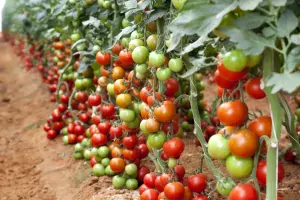
By Vincent Monda
Tomato farming in Kenya faced a mix of challenges and opportunities. Here’s a snapshot of the status, challenges, and opportunities for tomato farming in Kenya.
Status of Tomato Farming in Kenya
- Production:
Kenya is one of the leading tomato producers in Africa. Tomato farming is a significant agricultural activity in the country, with both small-scale and large-scale farmers involved in cultivation.
- Demand:
There is a consistent demand for tomatoes in Kenya, driven by the growing population and the use of tomatoes in various dishes, including staple foods like ugali and sauces.
- Varieties:
Farmers in Kenya typically grow various tomato varieties, including both open-pollinated and hybrid types, to cater to diverse market preferences.
Challenges
- Disease and Pest Management:
Tomato crops are susceptible to various diseases and pests, such as bacterial wilt, blight, and aphids. These can lead to significant crop losses if not adequately managed.
- Post-Harvest Losses:
Inefficient post-harvest handling and storage practices often result in substantial losses for farmers. This includes issues like spoilage, bruising, and damage during transportation.
- Lack of Access to Quality Inputs:
Some farmers may face challenges in accessing quality seeds, fertilizers, and pesticides, which can affect crop productivity.
- Market Price Fluctuations:
Tomato prices can be volatile due to factors like seasonality, supply and demand imbalances, and market manipulation. Farmers may struggle to get fair and stable prices for their produce.
- Infrastructure and Transportation:
Inadequate transportation and storage infrastructure can lead to delays in getting the produce to market and contribute to post-harvest losses.
Opportunities
- Value Addition:
Processing tomatoes into products like tomato paste, puree, and canned tomatoes can add value to the crop and extend its shelf life.
- Export Potential:
There is a growing demand for Kenyan tomatoes in regional and international markets. Exporting tomatoes can be a lucrative opportunity for farmers.
- Greenhouse Farming:
Greenhouse technology allows for controlled environments that can mitigate some of the challenges related to disease, pests, and adverse weather conditions. It also enables year-round production.
- Training and Education:
Access to agricultural training and education can help farmers improve their farming practices and productivity.
- Government Support:
The Kenyan government and various agricultural organizations have initiated programs to support tomato farmers through access to credit, technology, and market linkages.
- Diversification:
Farmers can diversify their tomato farming with intercropping or rotating with other crops to improve soil health and reduce disease pressure.




Niko na shamba nataka kupanda hizo nyanya nataka nijue type Gani nzuri na madawa hutumika kiazi Gani? Sinajukua miezi mingapi?ndio unauza?